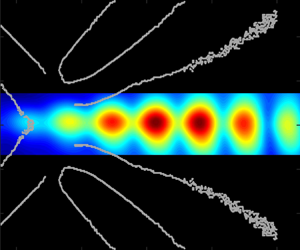Crossref Citations
This article has been cited by the following publications. This list is generated based on data provided by
Crossref.
Xu, Xiwang
Yi, Shihe
Quan, Pengcheng
Xiong, Haoxi
and
Nie, Liang
2023.
Experimental study on the hypersonic boundary layer transition induced by tandem cylinders.
Experimental Thermal and Fluid Science,
Vol. 145,
Issue. ,
p.
110901.
Tang, Yi-Wei
Huang, Wen-Feng
Yang, Qiang
and
Wang, Bo-Fu
2023.
α-, β-phenomena for the supersonic flow around an impulsively started circular cylinder.
AIP Advances,
Vol. 13,
Issue. 3,
Oliver, Timothy K.
2023.
Aerodynamic Interactions and Turbulence Mitigation by Unidentified Aerospace-undersea Phenomena.
Zhang, Huiying
Wallace, James M.
and
Wu, Xiaohua
2023.
Quantifying instantaneous flow reversal of tracer particles in subsonic, transonic and supersonic flows past a circular cylinder.
Journal of Turbulence,
Vol. 24,
Issue. 11-12,
p.
613.
Baidya, Rio
Scharnowski, Sven
de Silva, Charitha M.
Awasthi, Manuj
and
Kähler, Christian J.
2023.
Investigation of a Near-Field Cylinder Wake in the Subsonic, Transonic, and Supersonic Regimes.
AIAA Journal,
Vol. 61,
Issue. 12,
p.
5415.
Talluru, Murali Krishna
and
Gai, Sudhir
2023.
On oscillations in cylinder wakes at high speeds.
2023.
Numerical study on compressible flow around a circular cylinder in proximity to the wall.
Physics of Fluids,
Vol. 35,
Issue. 6,
Andrews, Philip S.
Lax, Philip A.
Thomas, Flint O
and
Leonov, Sergey B.
2024.
Visualization of sidewall vortices in rectangular nozzle supersonic blowdown wind tunnel.
Physics of Fluids,
Vol. 36,
Issue. 1,
Willmore, David J.
Lau, Timothy C.W.
Medwell, Paul R.
Kildare, Jordan A.C.
and
Evans, Michael J.
2024.
The influence of a bluff-body obstruction on the autoignition and flame acceleration of high-pressure hydrogen jets.
International Journal of Hydrogen Energy,
Vol. 110,
Issue. ,
p.
336.
Lax, Philip A.
Elliott, Skye
Gordeyev, Stanislav
Kemnetz, Matthew R.
and
Leonov, Sergey B.
2024.
Flow Structure behind Spanwise Pin Array in Supersonic Flow.
Aerospace,
Vol. 11,
Issue. 1,
p.
93.
Turner, Jacob M.
Seo, Jung Hee
and
Mittal, Rajat
2024.
A high-order sharp-interface immersed boundary solver for high-speed flows.
Journal of Computational Physics,
Vol. 500,
Issue. ,
p.
112748.
Akbarzadeh, Amir
and
Borazjani, Iman
2024.
Large eddy simulations of supersonic flow over a cylinder using an immersed boundary method.
Cheng, Xinlun
Nguyen, Phong C.H.
Seshadri, Pradeep K.
Verma, Mayank
Gray, Zoë J.
Beerman, Jack T.
Udaykumar, H.S.
and
Baek, Stephen S.
2024.
Physics-aware recurrent convolutional neural networks for modeling multiphase compressible flows.
International Journal of Multiphase Flow,
Vol. 177,
Issue. ,
p.
104877.
Thasu, Premika S.
Kumar, Gaurav
and
Duvvuri, Subrahmanyam
2025.
Aeroacoustic mechanisms explain universal behaviour in high-Mach number cylinder wakes.
Journal of Fluid Mechanics,
Vol. 1010,
Issue. ,
Awasthi, M.
McCreton, S.
Moreau, D.J.
and
Doolan, C.J.
2025.
Coherent oscillations and acoustic waves in a supersonic cylinder wake.
Journal of Fluid Mechanics,
Vol. 1012,
Issue. ,
Akbarzadeh, Amir M.
and
Borazjani, Iman
2025.
Parallel large eddy simulations with curvilinear immersed boundary method for high-speed flows.
Computers & Fluids,
Vol. 288,
Issue. ,
p.
106495.
Bienner, A.
Gloerfelt, X.
and
Cinnella, P.
2025.
Investigation of transonic flows through an idealized ORC turbine vane using Delayed Detached Eddy simulations.
Applied Thermal Engineering,
Vol. 261,
Issue. ,
p.
124951.

 $-$1 spectral roll-off observed in the schlieren spectra further upstream. The recompression wave exhibits low-frequency unsteadiness and a ripple-type motion which occurs as it is perturbed by shocklets radiating from the coherent structures in the wake. The wake consists of coherent disturbances with the same characteristic frequency as that for an incompressible flow over a cylinder; however, this instability is suppressed as the wake accelerates, presumably due to increasing compressibility. The primary instability of the wake flow has a characteristic frequency nearly twice that of its incompressible counterpart and it is shown to be driven by the presence of aeroacoustic resonance in the wake. It is also shown that the resonance, which leads to the formation of broadband standing waves in the wake, is the result of an interaction between the wake instabilities and upstream propagating acoustic waves in the wake. The acoustic waves originate upstream of the reattachment region and are believed to be generated by the unsteady separation on the cylinder surface.
$-$1 spectral roll-off observed in the schlieren spectra further upstream. The recompression wave exhibits low-frequency unsteadiness and a ripple-type motion which occurs as it is perturbed by shocklets radiating from the coherent structures in the wake. The wake consists of coherent disturbances with the same characteristic frequency as that for an incompressible flow over a cylinder; however, this instability is suppressed as the wake accelerates, presumably due to increasing compressibility. The primary instability of the wake flow has a characteristic frequency nearly twice that of its incompressible counterpart and it is shown to be driven by the presence of aeroacoustic resonance in the wake. It is also shown that the resonance, which leads to the formation of broadband standing waves in the wake, is the result of an interaction between the wake instabilities and upstream propagating acoustic waves in the wake. The acoustic waves originate upstream of the reattachment region and are believed to be generated by the unsteady separation on the cylinder surface.